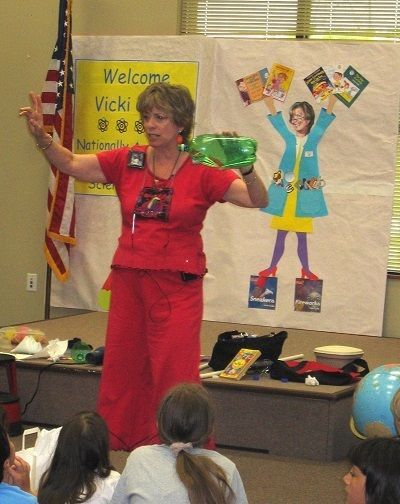Earning a livelihood as a children’s nonfiction author is no easy task. None of us can afford to be Emily Dickinson, sitting in an attic and pondering what it takes to make a prairie. So we cobble together an income from a variety of sources that include royalties (children’s books tend to stay in print longer than adult trade books), advances on royalties on upcoming books, and we do speaking engagements also known as school visits.

My act consisted of experiencing two noses (an illusion), levitating ping-pong balls, stabbing a water-bomb without exploding it, and blowing up toilet paper. All was infused with snappy patter. What’s not to like?
School visits have become the tail that wagged the dog. It is a BIG day for a school; most likely funded by bake sales of the PTA. It is considered enrichment. Children will get to meet and interact with a real person who writes books that they’ve read (if we’re lucky.) We are taking advantage of our celebrity culture that makes a lowly author queen-for-a-day. It is also an opportunity to sell books, which we sign, giving tangible evidence of a thrilling memory. They are the means by which I made it out of poverty to the middle class. I have played 49 of the fifty states, Canada, Mexico, Japan. The schools that chose me were self-selected groups, fairly affluent with the value that reading is important. Make no mistake. I was in show business.
In 2008, the recession hit and the first thing to go was the school visit. The PTA funds that we enjoyed were now needed for gas for the school bus. I suddenly had plenty of time to think. I began thinking about the school visit from the point of view of the students. Yes, it was an exciting day. From the kids’ point of view it was a day of entertainment (and kids really know how to be entertained.) But it was one and done. Maybe there was a residual effect of reading autographed books in the library for years to come and knowing an author was there. But for the most part, children didn’t wake up every day, excited about their schedule. Author Day was an exception. During a school visit, I did the work to entertain them. I had the joy of the work. They reacted. I started thinking that they needed to experience the joy of work that I create for myself every day. It is too simplistic to say that I love learning, which I do. Because learning isn’t always fun. But the payoff is worth the struggle. How could I unpack my process of creation so that they experienced it for themselves and would discover how to create something uniquely their own?
Was there a more affordable way to bring authors to schools? How could we make research, love of content and the creation of works to be shared with others—the motivation behind our careers—become something students do? Children’s authors have hard-won skills; we must make difficult concepts accessible, we must be engaging, we must build the motivation to learn into the craft of writing. Could we turn students into our apprentices? And would it be possible to do all this without the exhausting travel?
One result of the recession was that I founded iNK Think Tank , an organization of award-winning children’s nonfiction authors. Its mission is to promote the use of high-quality nonfiction in the classroom. About a dozen of us decided to create a division, Authors-on-Call, to pioneer a new kind of author visit using technology—interactive videoconferencing. We would interact with smaller groups—no more than two classes. We would present carefully crafted interactive programs that gave teachers lots of follow ups. We could be booked on short notice, since there were no travel arrangements to be made and we would make our programs available through the Center for Interactive Learning and Collaboration—a 25-year-old nonprofit that has become the main gateway for content providers to reach schools through interactive videoconferencing. If you look for Authors on Call/iNK Think Tank, on the CILC website under “Content Providers,” you’ll see that we have listed more than fifty programs on many subjects.
Authors-on-Call is still a work in progress. It takes a lot of creative thinking to shift the learning to the children. We can make more than one visit to a classroom and collaborate with both teachers and students to produce a group project. For the children, the distance between us becomes transparent. Proof? After I did a program for some students in Louisiana, they asked if they could take a picture with me. I think it’s worth a thousand words.

